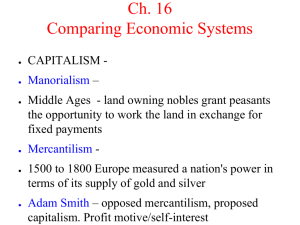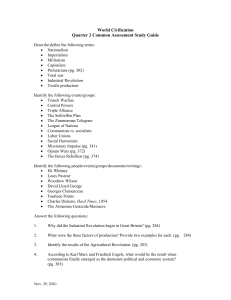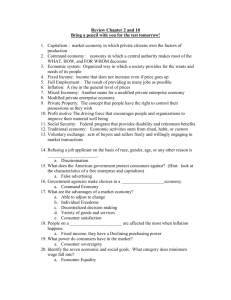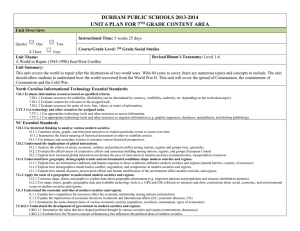Economic_Systems_guided_notes
advertisement
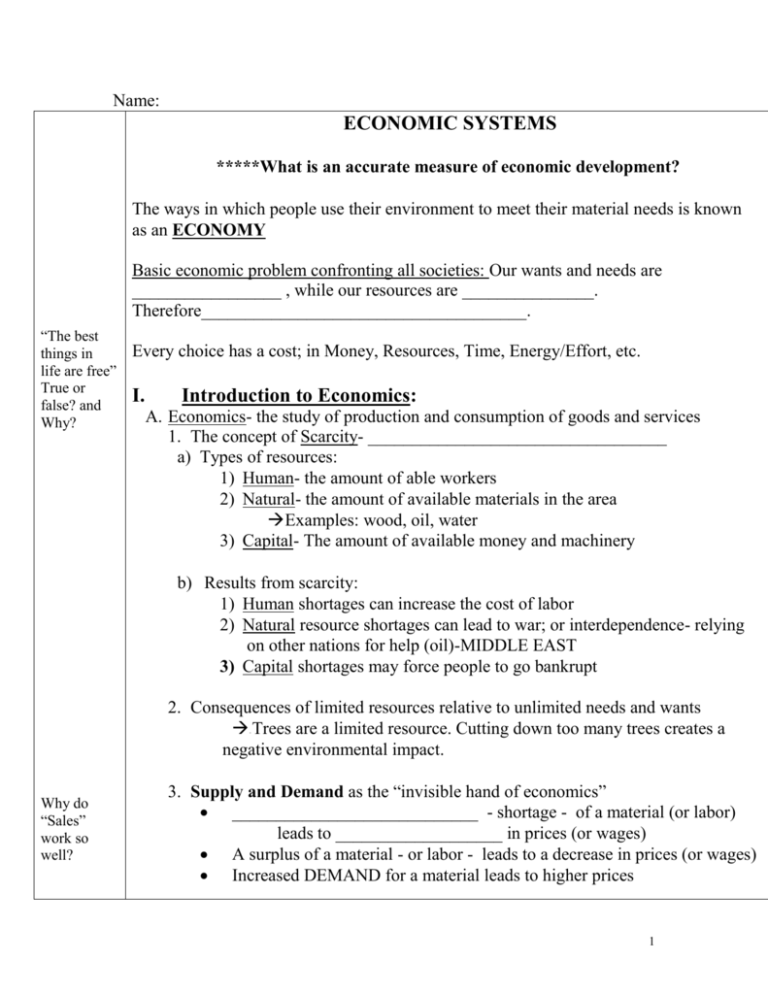
Name: ECONOMIC SYSTEMS *****What is an accurate measure of economic development? The ways in which people use their environment to meet their material needs is known as an ECONOMY Basic economic problem confronting all societies: Our wants and needs are _________________ , while our resources are _______________. Therefore_____________________________________. “The best things in life are free” True or false? and Why? Every choice has a cost; in Money, Resources, Time, Energy/Effort, etc. I. Introduction to Economics: A. Economics- the study of production and consumption of goods and services 1. The concept of Scarcity- __________________________________ a) Types of resources: 1) Human- the amount of able workers 2) Natural- the amount of available materials in the area Examples: wood, oil, water 3) Capital- The amount of available money and machinery b) Results from scarcity: 1) Human shortages can increase the cost of labor 2) Natural resource shortages can lead to war; or interdependence- relying on other nations for help (oil)-MIDDLE EAST 3) Capital shortages may force people to go bankrupt 2. Consequences of limited resources relative to unlimited needs and wants Trees are a limited resource. Cutting down too many trees creates a negative environmental impact. - Why do “Sales” work so well? 3. Supply and Demand as the “invisible hand of economics” ____________________________ - shortage - of a material (or labor) leads to ___________________ in prices (or wages) A surplus of a material - or labor - leads to a decrease in prices (or wages) Increased DEMAND for a material leads to higher prices 1 If we as a class were to open a Pizza shop of our own, how would we answer the 3 basic questions? 1: Decrease in DEMAND for a material leads to lower prices. 4. Basic Economic Concepts/Terms: Consumers- ____________________________ services and goods Goods - items of value Service - healthcare, education, legal advice Wants - things humans want to have, but are not necessary for survival Needs - items humans need in order to survive Resources - natural sources of wealth, become limited Demand - ____________________________________________ to purchase at fair prices Supply - ______________________________________________ B. The three basic economic questions that every economy must answer: 1. _______ will be produced? - what product will be manufactured 2._______ will it be produced? - By hand, in a factory, by machine 3. __________will it be produced? - What market are you selling to II. Types of Economic Systems 2: A) Earliest Economic Systems used the barter system (i) Goods of equal value traded __________________________ (ii) Money systems not yet invented 3: 2) Hunter/gatherer- people that had to rely on nature to survive, people were often nomads- members of a group of people with no fixed home, who traveled constantly to find food and water. Limited Resources a) Small human populations made hunter gather economies possible B) More Advanced Economic Systems 1) With the development of farming or agrarian societies, as the human population grew a more sophisticated economy was developed 2) Societies transitioned from a barter system to the use of _______________ ____________________________________________________________ 3) Traditional economy: economic decisions are based on customs and past practices 2 Is there a problem with the Manoralism model? Under Feudalism, Land = Power. In a trading economy, what now equals power? 4) Agrarian -a society based on farming. No manufacturing on a large scale. a) Barter System used. Farmers used their extra crops or livestock to trade b) MANORALISM: the Agrarian economic system of the Middle Ages (700 – 1300 CE) During the Middle Ages, kings were not strong enough to stop invasions. People needed protection. A new political system, called feudalism developed. In feudal society, powerful lords owned large pieces of land. They divided this land into estates. (FIEF). 1. Manoralism- Warfare made trade almost impossible, so the manor produced nearly everything that was needed. 2. Manors were self-sufficient- Manors produced everything for surviving (food and clothes from crops and animals) 3. Each manor included pastures for livestock, fields for crops, forest areas, and a village where the peasants lived 4. ______________________________________________ for the peasants and serfs. In return for the lord’s protection, the _____ _____________________________________________ for the lord If peasants used the Lord’s oven to bake bread, peasant must leave a loaf or two as payment. repaired roads and bridges Blacksmiths, carpenters, shoemakers, miller and vintner all lived in this setting. C) Modern Economic Systems: Rise of Market Economies (Capitalism) and a new powerful Middle Class 1) Trading economy- groups in the Mediterranean started to sail to other countries and sell their goods $$ will be used, instead of bartering. (1300’s) Cultural Diffusion Tried to diversify- traded to gain new/different products Started to see colonies-a settlement of people outside their homeland, linked with the parent country by trade. * Mother country benefits economically Mercantilism(1500s) 2) COMMERCIAL REVOLUTION a) By the l600s the nation had replaced the city and village as the basic economic unit in Europe 3 b) New methods of investing $$ came about, increasing the flow of wealth and reducing risks known as COMMERCIAL REVOLUTION (i) Nations competed for new markets during the Age of Exploration c) Raising money was a problem for overseas trading: costs of ships, crew, and goods was extremely high (i) Merchants started to turn toward ____________ for money- loans _________________________________________________. (ii) Individual merchants who wanted to invest in exploration often raised money by combining their resources in: joint stock companies- organizations that sold stock, enabling small investors to share in the profits. (i) if loss occurred, the investor only lost amount invested a. Dutch East India Company was a powerful joint stock co. b. Had the power to make war, seize foreign ships, coin money, and establish colonies and forts. (iii) Making a profit drove this entire movement Mercantilism- a state’s power depended on its wealth ________________________________________________ by mother country- Mother country benefits _______________________________________________, as well as vital ___________for finished goods Nations sought to create a favorable balance of trade by exporting more goods than they imported!!!! - 3) INDUSTRIAL REVOLUTION a) A major change in the way people live, work and think began over 200 years ago and in many ways is still going on today. This change is called the Industrial Revolution, and it accomplished the replacement of human and animal power with machines. What is a potential problem with Laissez Faire? b) _______________________________________________________ (1776) becomes the economic philosophy of the age. (i) Businesses are much more efficient in the use of resources than governments (ii) As a result, _________________________________ or regulate business activity (hands off) : ___________________________ 4 c) The Industrial Revolution began in England during the 1750's In our current economy, does the gov’t get involved in economic affairs? (i) Causes: Why did________________________________________? England was rich in ___________________________(coal, iron) England had natural harbors (______________________), and a strong infrastructure (canals, bridges and roads) England had ____________________________(capital) to invest England had an excellent navy and was able to expanded its colonial empire (increasing its ability to obtain natural resources and reach foreign markets) England had a stable and supportive government Enclosure Movement- forced small farmers off land, (i) Homeless, they moved to the cities, creating a surplus of labor. d) Results or Changes in Society: (i) From handmade goods to ________________________ - faster & cheaper process (ii) From production at home (domestic system) to ___________________________________________________ (iii) From producing small amounts to ___________________ (iv) The increased use of science and new forms of energy (steam power) to speed up production. (New technology) (v) People move from rural (country) areas to urban area (city) URBANIZATION CONDITIONS FOR WORKERS: -Long hours (16-18 a day) -Low pay (maybe $.03-.04 an hr.) -Unsafe working conditions -Child labor -Overcrowding of cities- unsanitary and diseases 5 Why do socialism and Communism have appeal to people? D) The Rise of Eastern European Economic Systems as a result of the abuses of Capitalism 1) Socialism a) Not everyone in Europe agreed with the capitalist way of thinking in the early 1800s. Some people believed that ending the misery of workers required eliminating capitalism completely b) Socialism- __________________________________________ - capital, land, raw materials, and factories - ________________ and controlled by society, either directly or through___________________. 2) Command Economy- (COMMUNIST) Economic and political system where government has total control over the production of goods and services. a) ___________________________________________________ (1848) (i) Believed that economics was the major force of change (ii) The most important aspect of the economic base was the division of society into classes Conflict between classes was inevitable Bourgeoisie - middle class They controlled production and became the new ruling class ________________________________, the “new” slave or serf (iii) Marx’s socialist idea was background for Communism Can Communism EVER work effectively? B. COMMUNISM (Soviet Union) Lenin and the Bolsheviks had introduced an economic Policy called communism in 1918. Government carried a policy of________________________, in which it brought ___________________________________ Collectivization, a system of farming in which ___________ ______________________and then used them to work the land While initially appealing to the common man, Communism proved to be a heavily flawed political system, and _________ __________________________________________________. 6 Look at the chart to the right. In considering the current US economy, we’re not a Command Economy, but are we a PURE Market Economy? Explain your answer. A Comparison of Market & Command Economies Market Economy Command Economy Ownership Little public control Economic Controls Market Forces Focuses on industrial goods 7


